
A seashell or sea shell, also known simply as a shell, is a hard, protective outer layer usually created by an animal or organism that lives in the sea. Most seashells are made by mollusks, such as snails, clams, and oysters to protect their soft insides. Empty seashells are often found washed up on beaches by beachcombers. The shells are empty because the animal has died and the soft parts have decomposed or been eaten by another organism.
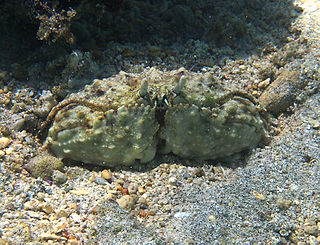
Calappa hepatica, the reef box crab, is a common benthic species of box crab of tropical and subtropical parts of the Indian and Pacific Oceans and the Red Sea.
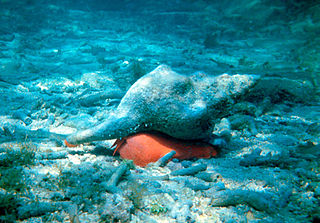
Triplofusus giganteus, commonly known as the Florida horse conch, or the giant horse conch, is a species of extremely large predatory subtropical and tropical sea snail, a marine gastropod mollusc in the family Fasciolariidae, the spindle snails, tulip snails and their allies. On average, it weighs over 11 pounds (5.0 kg).

The halloween hermit crab, also known as the striped hermit crab or orange-legged hermit crab, is a brightly colored aquatic hermit crab of the family Diogenidae. Besides its ability to routinely clean algae in aquaria, the halloween hermit crab's festive striped coloration also appeals to enthusiasts; it is considered the most brightly colored hermit crab in normal aquarium use.

Calappa is a genus of crabs known commonly as box crabs or shame-faced crabs. The name box crab comes from their distinctly bulky carapace, and the name shame-faced is from anthropomorphising the way the crab's chelae (claws) fold up and cover its face, as if it were hiding its face in shame.

The Scotch bonnet is a medium-sized to large species of sea snail, a marine gastropod mollusk in the subfamily Cassinae, the helmet shells and bonnet shells. The common name "Scotch bonnet" alludes to the general outline and color pattern of the shell, which vaguely resemble a tam o' shanter, a traditional Scottish bonnet or cap. The shell is egg-shaped and fairly large, 2 to 4 inches in maximum dimension, with a regular pattern of yellow, orange or brown squarish spots. The surface sculpture of the shell is highly variable: the surface can be smooth and polished, have grooves, be granulated, or even be nodulose on the shoulder of the whorls.

Charybdis is a genus of swimming crabs in the family Portunidae. It is named after the monster Charybdis of Greek mythology.

Amphioctopus marginatus, also known as the coconut octopus and veined octopus, is a medium-sized cephalopod belonging to the genus Amphioctopus. It is found in tropical waters of the western Pacific Ocean. It commonly preys upon shrimp, crabs, and clams, and displays unusual behavior including bipedal and quadrupedal walking as well as tool use.
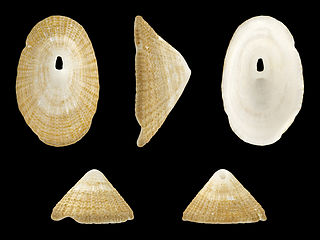
Diodora cayenensis, the Cayenne keyhole limpet, is a species of small to medium-sized sea snail or limpet, a western Atlantic marine prosobranch gastropod mollusk in the family Fissurellidae, the keyhole limpets.

The green ormer is a northeast Atlantic and Mediterranean species of sea snail, a coastal marine gastropod mollusc in the family Haliotidae, the abalones or ormer snails.

Eriphia verrucosa, sometimes called the warty crab or yellow crab, is a species of crab found in the Black Sea, Mediterranean Sea and eastern Atlantic Ocean from Brittany to Mauritania and the Azores. Individual crabs have been caught as far north as Cornwall. Formerly a frequent species in the Black Sea, it has decreased in numbers since the 1980s and is now listed in the Ukrainian Red Data Book of endangered species.

Monoplex pilearis, common name the hairy triton, is a species of medium-sized predatory sea snail, a marine gastropod mollusk in the family Cymatiidae.
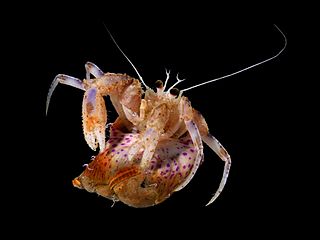
Pagurus prideaux is a species of hermit crab in the family Paguridae. It is found in shallow waters off the northwest coast of Europe and usually lives symbiotically with the sea anemone Adamsia palliata.
Hypothalassia acerba is a large crab found in the muddy substrates of the deep seas off the southwestern Australian and New Zealand coasts. Australian distribution, which is correlated to depth and temperature, ranges from a latitude as far north as approximately 27° S on the west coast, southwards, then eastwards on the south coast to a longitude of at least 129° E. The species usually occurs in waters with temperatures of 13–19 °C (55–66 °F) and in depths ranging of 200–255 metres (656–837 ft) on the lower west coast and 90–200 m (300–660 ft) on the south coast. Body size is inversely related to depth of water. There are only two species in the genus Hypothalassia, and H. acerba is not the same champagne crab as the other Hypothalassia species, H. armata, which is found in Japanese waters.

Calappa gallus, common name rough box crab, or lumpy box crab, and Hawaiian name poki poki, is a benthic species of box crab in the family Calappidae.

Calappa calappa, also known as the smooth box crab or red-spotted box crab, is a tropical marine species of crab with an Indo-Pacific distribution, and showing great variability in its patterning and colouration. First described as Cancer calappa by Linnaeus in 1758 from a specimen originating from Ambon Island, and later in 1781 as Cancer fornicatus by Fabricius, it was finally placed in the genus Calappa by Lancelot Alexander Borradaile in 1903. The name calappa is associated with kelapa, the Malay word for 'coconut'.
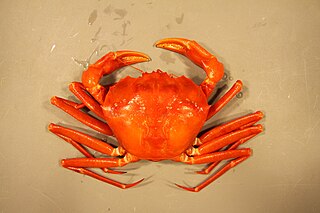
Chaceon quinquedens, commonly known as the red deep-sea crab, but sold as Atlantic deep sea red crab, or simply Atlantic red crab or red crab, is a crab that lives in the Atlantic Ocean off the East Coast of the United States and Canada, from North Carolina to Nova Scotia, and in the Gulf of Mexico.
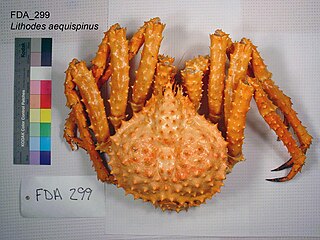
Lithodes aequispinus, the golden king crab, also known as the brown king crab, is a king crab species native to the North Pacific. Golden king crabs are primarily found in the Aleutian Islands and waters nearer to Alaska and British Columbia; their range also extends to the Russian far east and Japan, albeit with a less dense population. Golden king crabs are the smallest of the three commercially viable Alaskan king crab species with an average weight between 5 and 8 lbs ; the other two species being the blue and red king crabs. Golden king crabs were historically caught incidentally in red king crab fisheries, but the first commercial landing took place in 1975; in 1981, the targeted pot-fishing method, a hybrid fishing method specifically for golden king crab, was developed.
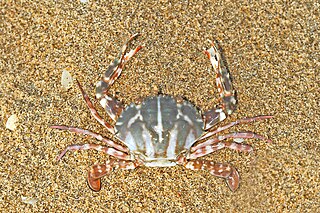
Charybdis feriata, the crucifix crab, is a species of swimming crab in the family Portunidae. It is found in the tropical and subtropical Indo-Pacific region.

Hepatus pudibundus, the flecked box crab, is a crab from the class Malacostraca. They are found in the Atlantic Ocean with Brazil having a dense population of H. pudibundus, as they are one of the most commonly seen crabs in the country. Many of the studies done on H. pudibubus have occurred in the Ubatuba region of Brazil, where there is a rapid expansion of tourism that is affecting marine ecosystems.


















